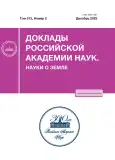MONITORING OF ARSENIC AND MERCURY CONTENT IN AGROECOSYSTEMS OF THE CENTRAL CHERNOZEMIC REGION OF RUSSIA
- Authors: Lukin S.V.1,2
-
Affiliations:
- Belgorod Center for Agrochemical Service
- Belgorod State National Research University
- Issue: Vol 513, No 2 (2023)
- Pages: 308-314
- Section: GEOECOLOGY
- Submitted: 30.12.2023
- Published: 01.12.2023
- URL: https://journals.rcsi.science/2686-7397/article/view/247174
- DOI: https://doi.org/10.31857/S268673972360131X
- EDN: https://elibrary.ru/HZCOJX
- ID: 247174
Cite item
Full Text
Abstract
The work analyzed the results of state agroecological monitoring of soils carried out in the southwestern part of the forest-steppe zone of the Central Chernozemic region of Russia. It was found that the average gross content of As and Hg in horizon A of arable chernozem of the typical forest-steppe zone of the Central Chernozemic region is 4.18 and 0.022 mg/kg, respectively. In the parent rock (C), the content of As is 1.38 times higher, and Hg is 2.22 times lower than in A. In the agroecosystems of the Belgorod region organic fertilizers are the main source of As and Hg, but this does not pose a danger to soil pollution and crop production. The highest average As content (0.020 mg/kg) was found in winter wheat grains, peas and sunflower seeds, and the lowest (0.016 mg/kg) was found in corn and soybean grains. The highest content of Hg is characterized by barley grains (0.006 mg/kg) and winter wheat (0.007 mg/kg), and the lowest content of this element (0.002 mg/kg) was noted in esparcet hay. Exceeding the levels of maximum allowable concentration of As and Hg for food grains and maximum allowable level for feed products was not revealed in the studies.
About the authors
S. V. Lukin
Belgorod Center for Agrochemical Service; Belgorod State National Research University
Author for correspondence.
Email: serg.lukin2010@yandex.ru
Russian, Belgorod; Russian, Belgorod
References
- Виноградов А.П. Геохимия редких и рассеянных химических элементов в почвах. М.: изд-во АН СССР, 1957. 238 с.
- Kabata-Pendias A. Trace Elements in Soils and Plants, 2011. 505 p.
- Rovira J., Nadal M., Schuhmacher M., Domingo J.L. Concentrations of trasse elements and PCDD/Fs around a municipal solid waste in cinerator in Girona (Catolonia, Spain). Human health risks for the population living in the neighborhood // Sci Total Environ. 2018. V. 630. P. 34–45.
- Toth G., Hermann T., Szatmari G., Pasztor L. Maps of heavy metals in the soils of the European Union priority areas for detailed assessment // Science of the Total Environment. 2016. V. 565. P. 1054–1062.
- Побилат А.Е., Волошин Е.И. Экологическая оценка содержания ртути в агроценозах Средней Сибири // Микроэлементы в медицине. 2019. № 20 (4). С. 57–62. https://doi.org/10.19112/2413-6174-2019-20-4-57-62
- Semenkov I.N., Koroleva T.V. International Environmental Legislation on the Content of Chemical Elements in Soils: Guidelines and Schemes // Eurasian Soil Science. 2019. V. 52. № 10. P. 1289–1297. https://doi.org/10.1134/S1064229319100107
- Chen Sh., Wang M., Li Sh., Zhao Zh.E.W. Overview on current criteria for heavy metals and its hint for the revision of soil environmental quality standards in China // J. Integrative Agriculture. 2018. V. 17. № 4. P. 765–774. СанПиН 1.2.3685-21 “Гигиенические нормативы и требования к обеспечению безопасности и (или) безвредности для человека факторов среды обитания”. Утверждены Постановлением Главного государственного санитарного врача РФ от 28.01.2021 № 2.https://doi.org/10.1016/S2095-3119(17)61892-6
- СанПиН 1.2.3685-21 “Гигиенические нормативы и требования к обеспечению безопасности и (или) безвредности для человека факторов среды обитания». Утверждены Постановлением Главного государственного санитарного врача РФ от 28.01.2021 № 2”.https://doi.org/10.1016/S2095-3119(17)61892-6
- Безуглова О.С., Околелова А.А. О нормировании содержания мышьяка в почвах // Живые и биокосные системы. 2012. № 1. (Режим доступа: URL: https://jbks.ru/archive/issue-1/article-7). https://doi.org/10.18522/2308-9709-2012-1-7.
- ТРТС015/2011 Технический регламент Таможенного союза “О безопасности зерна” (с изменениями на 15 сентября 2017 года) Технический регламент Таможенного союза от 09.12.2011 N015/2011. Режим доступа: docs.cntd.ru›document/902320395 (дата обращения: 03.02.2023).
- ВМДУ-87 “Временный максимально допустимый уровень содержания некоторых химических элементов и госсипола в кормах для сельскохозяйственных животных и кормовых добавках”, 1987.
- Методические указания по проведению локального мониторинга на реперных и контрольных участках / В.Г. Сычев, А.В. Кузнецов, А.В. Павлихина и др. Москва: Росинформагротех, 2006. 76 с.
- Методические указания по определению тяжелых металлов в почвах сельхозугодий и продукции растениеводства. М.: Типография Московской с.-х. академии им. К.А. Тимирязева, 1992. 61 с.
- Почвы Липецкой области / Ю.И. Сискевич, В.А. Никоноренков, О.В. Долгих и др. Липецк: Изд-во ООО “Позитив Л”, 2018. 209 с.
- Перельман А.И. Геохимия ландшафта. М.: Высшая школа, 1975. 342 с.
- Селюкова С.В. Экологическая оценка содержания свинца, кадмия, ртути и мышьяка в агроэкосистемах юго-западной части Центрально-Черноземного района России. Автореферат на соискание ученой степени кандидата биологических наук. М.: РГАУ – МСХА имени К.А. Тимирязева, 2019. 25 с.
- Chekmarev P.A., Lukin S.V., Selyukova S.V. Monitoring of mercury content in agroecosystems of the central chernozem region of Russia // Pollution Research. 2021. V. 40. № 1. P. 34–39.
- Медведев И.Ф., Деревягин С.С. Тяжелые металлы в экосистемах. Саратов: “Ракурс”, 2017. 178 с.
- http: // www.fedstat.ru/indicators/stat.do (дата обращения 24.03.2023).
- Побилат А.Е., Волошин Е.И. Микроэлементы в сельскохозяйственных растениях // Микроэлементы в медицине. 2021. № 22 (3). С. 3V14. https://doi.org/10.19112/2413-6174-2021-22-3-3-14
Supplementary files










